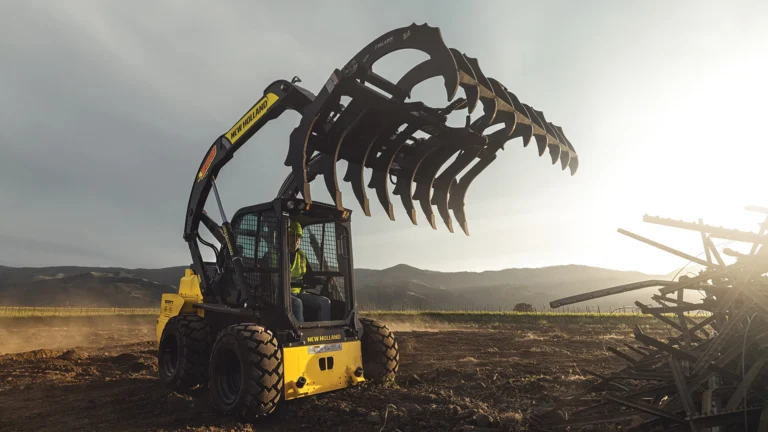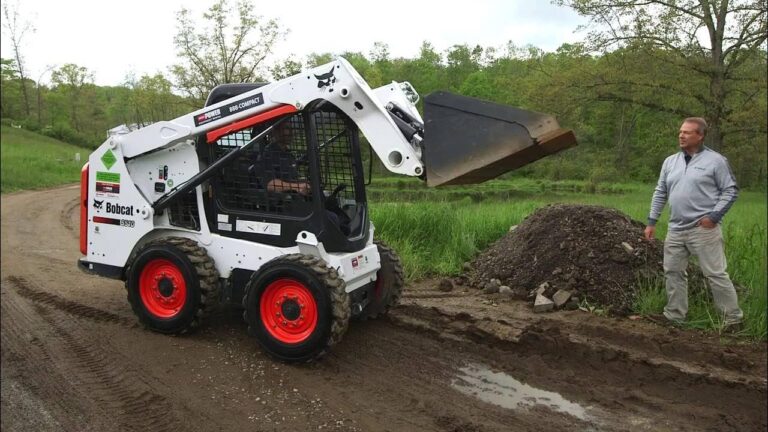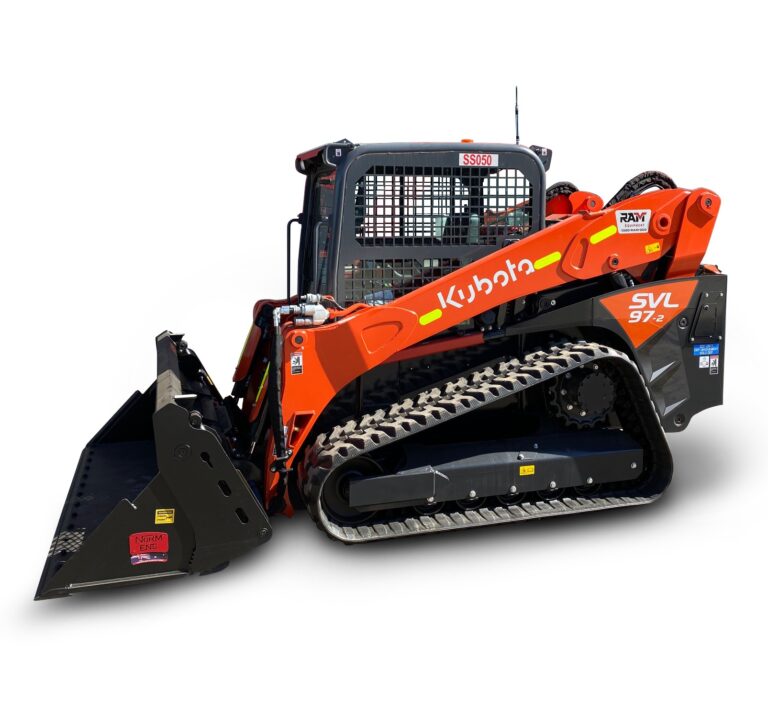Skid Steer Tracks: Enhance Your Machine’s Performance
Skid steer tracks enhance traction and stability on various terrains. They are essential for improving performance in muddy, snowy, or uneven conditions.
Skid steer tracks are vital components for enhancing a skid steer loader’s functionality. These tracks provide better ground contact, reducing ground pressure and preventing damage to delicate surfaces. Ideal for construction, landscaping, and agricultural tasks, they offer superior traction compared to traditional wheels.
Users often face challenges like slippage on wet ground or difficulty navigating rough terrains. Tracks help overcome these obstacles, allowing for smoother operation and improved efficiency. Various types of tracks are available, each designed for specific applications, ensuring that operators can choose the best option for their needs. Investing in quality skid steer tracks can significantly boost productivity and performance on the job site.

Credit: www.bigrentz.com
Introduction To Skid Steer Tracks
Skid steer tracks play a vital role in construction and landscaping. They provide stability and traction on various terrains. Understanding these tracks helps operators select the right equipment.
Basics Of Skid Steer Functionality
A skid steer loader is a compact, versatile machine. It uses a unique steering system. This system allows for tight turns and precise movements.
- Skid steers operate by varying the speed of each track.
- The operator can control the machine easily.
- They are ideal for small spaces and tricky terrains.
Skid steers can handle various attachments. These include buckets, forks, and grapples. The choice of tracks impacts overall performance.
The Role Of Tracks In Performance
Skid steer tracks significantly affect performance. They provide better grip on uneven surfaces. This enhances stability and safety for the operator.
| Type of Track | Best For | Benefits |
|---|---|---|
| Rubber Tracks | Soft Soil | Minimal ground damage |
| Steel Tracks | Rocky Terrain | Durability and strength |
| Combination Tracks | Mixed Conditions | Versatility |
Choosing the right track is essential. It improves efficiency and reduces wear on the machine. Proper maintenance extends track life and enhances performance.
Types Of Skid Steer Tracks
Choosing the right type of skid steer track is essential. Different tracks suit various terrains and applications. Understanding the options helps in making the best choice.
Rubber Tracks
Rubber tracks are the most common choice. They offer a smooth ride on hard surfaces. Here are some key benefits:
- Excellent traction on various terrains.
- Less damage to the ground.
- Quiet operation.
Rubber tracks are suitable for:
- Landscaping projects
- Construction sites
- Residential work
They come in different sizes and tread patterns. This allows for customized performance.
Steel Tracks
Steel tracks are robust and durable. They excel in rough, uneven terrains. Key features include:
- High resistance to wear and tear.
- Superior traction in mud and snow.
- Longer lifespan compared to rubber tracks.
Use steel tracks for:
- Mining operations
- Heavy-duty construction
- Rough terrain work
They can increase the weight of the skid steer. This can improve stability on uneven ground.
Over-the-tire (ott) Tracks
OTT tracks fit over existing tires. They provide extra traction without replacing tires. Benefits include:
- Easy installation and removal.
- Cost-effective solution for better traction.
- Flexibility for different job sites.
OTT tracks work well in:
- Soft ground conditions
- Snowy areas
- Wet environments
They can extend the life of standard tires. This makes them a popular choice among operators.
Comparing Track Materials
Choosing the right track material for skid steers is crucial. Each material has unique properties. This affects performance, durability, and cost. Let’s explore different track materials in detail.
Durability And Lifespan
Durability is vital for skid steer tracks. Strong materials last longer and require less maintenance. The most common materials include:
- Rubber: Flexible and good for various terrains.
- Steel: Extremely durable but heavier.
- Composite: Combines benefits of rubber and steel.
Rubber tracks typically last between 2,000 to 3,000 hours. Steel tracks can last up to 5,000 hours. Composite tracks fall in between. The right choice depends on your working conditions.
Traction And Stability
Good traction ensures safety and efficiency. Different materials offer varying levels of grip:
| Material | Traction Level | Stability |
|---|---|---|
| Rubber | High | Good |
| Steel | Medium | Excellent |
| Composite | High | Very Good |
Rubber tracks offer excellent grip on soft surfaces. Steel tracks perform well on hard, uneven ground. Composite tracks provide a balance of both.
Surface Impact And Versatility
Different surfaces require specific track materials. Here’s how they perform:
- Rubber Tracks: Best for soft soil and asphalt.
- Steel Tracks: Ideal for rocky and rugged terrains.
- Composite Tracks: Versatile for multiple surfaces.
Rubber tracks reduce surface damage. Steel tracks can cause more wear on delicate surfaces. Composite tracks minimize impact while providing versatility.
Installation Tips For Skid Steer Tracks
Installing skid steer tracks can enhance your machine’s performance. Follow these tips to ensure a smooth installation. Proper techniques lead to better traction and durability.
Preparation Steps
- Gather necessary tools: wrenches, sockets, and a jack.
- Choose a flat, dry area for installation.
- Inspect the skid steer for any damage.
- Clean the wheels and remove any debris.
- Check the manufacturer’s instructions for specific guidance.
Proper Installation Techniques
- Lift the skid steer using a jack.
- Remove the existing wheels carefully.
- Align the tracks with the mounting points.
- Attach the tracks using the provided hardware.
- Ensure all bolts are tightened securely.
- Lower the skid steer and check the alignment.
- Test drive the skid steer to ensure smooth operation.
Following these steps will lead to successful installation. Remember, safety comes first. Always wear protective gear during installation.
Maintenance Best Practices
Maintaining your skid steer tracks is crucial for performance and longevity. Proper care prevents costly repairs. Follow these best practices to keep your tracks in top shape.
Regular Inspection Routines
Inspecting your skid steer tracks regularly helps catch problems early. Check for:
- Cracks or tears
- Excessive wear
- Foreign objects stuck in the tracks
Perform inspections after every use. Look for signs of damage. Replace tracks that show serious wear. A small issue can lead to big problems.
Cleaning And Storage
Keeping tracks clean is essential. Dirty tracks can wear out faster. Follow these steps:
- Wash the tracks with water and mild soap.
- Remove mud and debris.
- Dry completely before storage.
Store your skid steer indoors. Avoid direct sunlight and moisture. Proper storage extends the life of your tracks.
Track Tension Adjustment
Correct track tension ensures smooth operation. Too loose or too tight can cause damage. Follow these guidelines:
| Condition | Adjustment Needed |
|---|---|
| Tracks sagging or loose | Increase tension |
| Tracks too tight | Decrease tension |
Adjust tension according to the manufacturer’s guidelines. Regular adjustments help maintain optimal performance. Check tension every month or after heavy use.
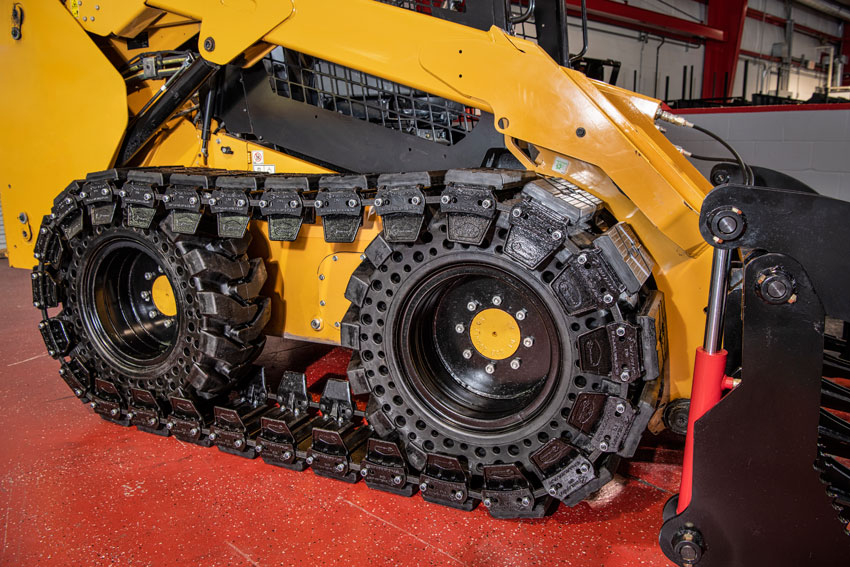
Credit: www.mclarenindustries.com
Performance Benefits
Skid steer tracks offer significant performance benefits. These advantages enhance efficiency and effectiveness on various terrains.
Improved Maneuverability
Skid steer tracks provide excellent maneuverability. Operators can navigate tight spaces easily. This feature is crucial in construction sites and landscaping projects.
- Quick turns
- Sharp angles
- Easy navigation
Operators can work around obstacles without delays. This leads to faster project completion.
Enhanced Load Handling
Tracks improve load handling capabilities. Skid steers can lift heavier loads effortlessly. This efficiency reduces the need for multiple trips.
| Load Type | Track Performance |
|---|---|
| Heavy Materials | Increased stability |
| Uneven Surfaces | Better traction |
| Loose Soil | Reduced slippage |
This efficiency enhances productivity on the job site. Operators can focus on their tasks without worrying about load instability.
Reduced Ground Disturbance
Skid steer tracks minimize ground disturbance. They spread weight over a larger surface area. This feature protects the soil and vegetation.
- Less soil compaction
- Preserves grass and plants
- Less damage to the environment
Reduced disturbance is vital for landscaping and agricultural tasks. Operators can work more sustainably with less impact.
Selecting The Right Tracks For Your Needs
Choosing the right tracks for your skid steer is crucial. The right tracks improve performance and extend the machine’s life. Consider multiple factors to make an informed choice. This section covers key aspects to help you decide.
Assessing Work Environment
Your work environment affects track selection. Different surfaces require different tracks. Assess the following:
- Terrain Type: Soft soil, gravel, or pavement?
- Weather Conditions: Rainy, snowy, or dry?
- Load Requirements: Heavy lifting or light tasks?
Choose tracks that fit your specific conditions. For example:
| Surface Type | Recommended Track Type |
|---|---|
| Soft Soil | Wide Tracks |
| Hard Pavement | Narrow Tracks |
| Wet or Muddy | Rubber Tracks |
Weight And Size Considerations
Weight and size of your skid steer matter. Heavier machines need stronger tracks. Check these factors:
- Machine Weight: Ensure tracks support the weight.
- Track Width: Wider tracks offer better stability.
- Track Length: Longer tracks improve traction.
Use the following guidelines:
- Light machines: Use standard tracks.
- Heavy machines: Choose reinforced tracks.
Compatibility With Skid Steer Models
Track compatibility is essential. Not all tracks fit every skid steer. Check the following:
- Manufacturer Guidelines: Follow the specific model requirements.
- Track System Type: Steel or rubber tracks?
- Attachment Points: Ensure alignment with your machine.
Use the track size chart for your model:
| Skid Steer Model | Recommended Track Size |
|---|---|
| Bobcat S650 | 12″x 52″ |
| CAT 259D | 10″x 48″ |
| John Deere 328E | 14″x 60″ |
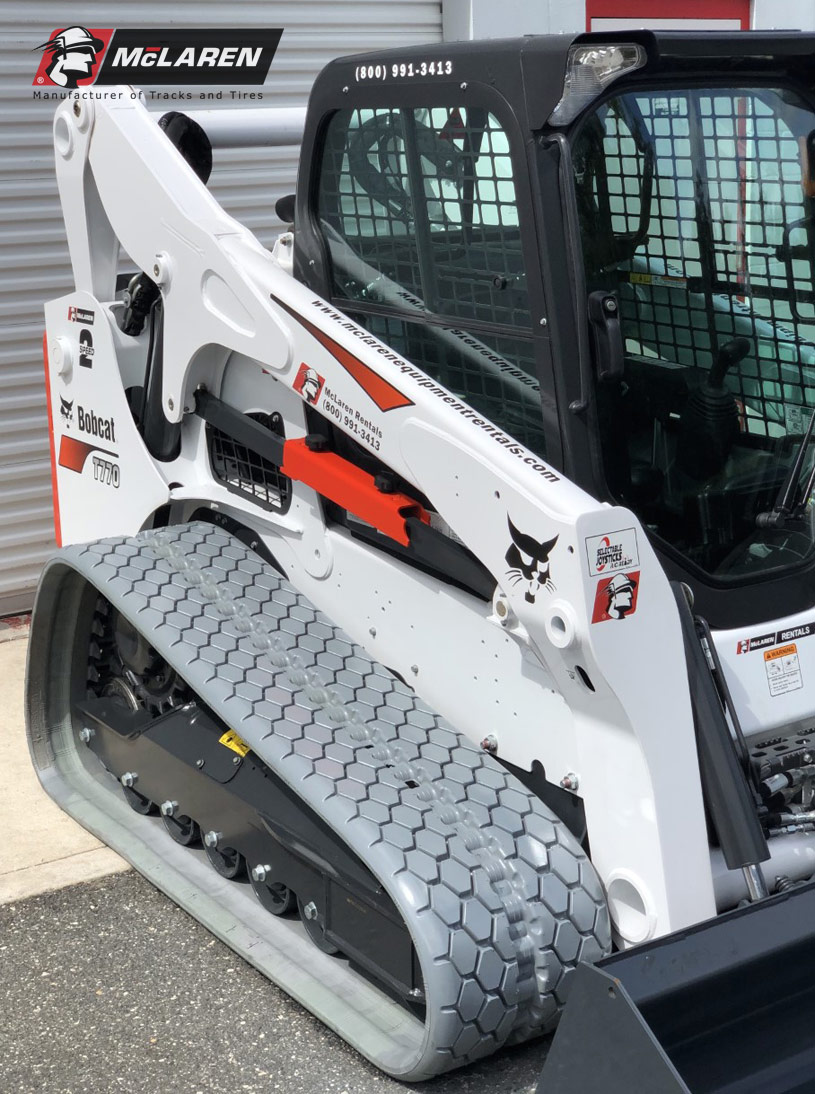
Credit: www.mclarenindustries.com
Case Studies: Tracks In Action
Skid steer tracks enhance performance across various industries. Here are real-world examples showing their impact.
Construction Site Efficiency
At a busy construction site, skid steer tracks improved efficiency significantly. Workers experienced:
- Reduced downtime
- Enhanced traction on uneven surfaces
- Better maneuverability in tight spaces
One project reduced completion time by 20%. Operators reported:
- Faster material transport
- Increased safety on site
These benefits highlight the importance of choosing the right tracks.
Agricultural Productivity
In agriculture, skid steer tracks revolutionized farming practices. Farmers enjoyed:
- Improved soil preservation
- Efficient crop management
- Less compaction on fields
A local farm reported a 30% increase in yield. Key factors included:
| Benefit | Impact |
|---|---|
| Soil Health | Longer-lasting crops |
| Fuel Efficiency | Lower operating costs |
Skid steer tracks transformed agricultural efficiency.
Landscaping Project Success
Landscapers also see remarkable results with skid steer tracks. Projects completed faster lead to:
- Better design execution
- Higher customer satisfaction
- More creative landscaping options
One landscaping company cut project time by 15%. Key achievements included:
- Quick material movement
- Smoother terrain preparation
These results demonstrate how tracks can elevate landscaping work.
Future Innovations In Skid Steer Tracks
The future of skid steer tracks promises exciting advancements. These innovations will enhance performance, sustainability, and maintenance. Let’s explore what lies ahead.
Advancements In Track Technology
New technologies are emerging for skid steer tracks. These advancements aim to improve traction and durability.
- Rubber compounds with better grip.
- Modular designs for easy replacement.
- Smart sensors for real-time performance data.
These features will allow for better maneuverability on various terrains. Operators can expect enhanced productivity.
Sustainable Materials
Manufacturers are focusing on eco-friendly materials. Sustainable options reduce environmental impact.
- Recycled rubber for track production.
- Biodegradable components in track design.
These materials offer durability while supporting eco-conscious practices. Sustainability is becoming a priority in the industry.
Predictive Maintenance Integration
Predictive maintenance is changing equipment management. Smart technology predicts wear and tear before it occurs.
- Real-time tracking of track conditions.
- Alerts for maintenance needs.
This system minimizes downtime and maximizes efficiency. Operators can address issues proactively.
Frequently Asked Questions
What Are Skid Steer Tracks?
Skid steer tracks are rubber or metal tracks designed to provide better traction and stability for skid steer loaders. They enhance performance on various terrains, especially soft or uneven surfaces. Tracks improve weight distribution, reducing ground pressure and minimizing damage to the ground, making them ideal for construction and landscaping.
How Do I Choose Skid Steer Tracks?
Choosing skid steer tracks depends on your specific needs. Consider the terrain you’ll be working on, the track material, and the width required. Rubber tracks are great for softer surfaces, while steel tracks are better for rough terrains. Always match the track size to your skid steer model for optimal performance.
Can I Replace My Skid Steer Tires With Tracks?
Yes, you can replace skid steer tires with tracks. This conversion can significantly improve traction and stability. However, ensure your skid steer is compatible with a track system. Consult with a professional or the manufacturer to confirm specifications and requirements for the conversion process.
How Often Should Skid Steer Tracks Be Replaced?
Skid steer tracks should be replaced every 1,000 to 2,000 hours of operation, depending on usage and conditions. Regular inspections can identify wear and tear early. Signs of damage include cracking, splitting, or irregular wear patterns. Timely replacement ensures optimal performance and safety during operation.
Conclusion
Choosing the right skid steer tracks is essential for optimal performance. Quality tracks enhance stability and efficiency on various terrains. Investing in the right tracks can save time and reduce maintenance costs. Make informed decisions to maximize your equipment’s potential and ensure your projects run smoothly and effectively.


